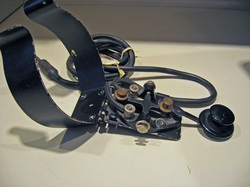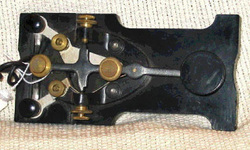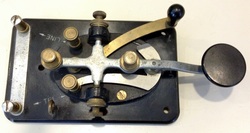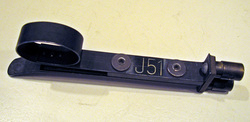United States Military Telegraph Keys
These keys were used by the US Military, primarily during and after World War II. The "J" prefix designation in many of the model numbers indicates that the key was used Jointly by the Army and the Navy. You can click on any of these images to enlarge them.

U.S. Army Signal Corps Flameproof Aircraft Telegraph Key Model J5-A:
This is a black metal key with a side arm straight lever and a black Navy knob. The enclosed mechanism has two terminals on the rear. The top plate is marked: Signal Corps U.S. Army; Flame Proof Key J5-A; Order No. 2670 NY 41; Made by LS Brach Co. Newark NJ. "The contacts are totally enclosed to allow them to be used in explosive environments without the danger of the contact sparks igniting an explosion." Tom Perera These keys were made in large quantities from 1918-1945 by the US military. [013]
This is a black metal key with a side arm straight lever and a black Navy knob. The enclosed mechanism has two terminals on the rear. The top plate is marked: Signal Corps U.S. Army; Flame Proof Key J5-A; Order No. 2670 NY 41; Made by LS Brach Co. Newark NJ. "The contacts are totally enclosed to allow them to be used in explosive environments without the danger of the contact sparks igniting an explosion." Tom Perera These keys were made in large quantities from 1918-1945 by the US military. [013]

J-37/J-45 Telegraph Key with Leg Clamp:
This is a model J-37 U.S.military straight key with a leg clamp. This key was used by the US Military during WW II in tanks, planes, and other vehicles. They were made by, at least, five different manufacturers. The key was clamped to the operator's leg and it folds downward on a hinge at the rear of the key. The J-37 key with the leg strap is called a J45. Because it is stamped " KY-116/U," this is a post World War II model.[001]
This is a model J-37 U.S.military straight key with a leg clamp. This key was used by the US Military during WW II in tanks, planes, and other vehicles. They were made by, at least, five different manufacturers. The key was clamped to the operator's leg and it folds downward on a hinge at the rear of the key. The J-37 key with the leg strap is called a J45. Because it is stamped " KY-116/U," this is a post World War II model.[001]

J-37 Military Telegraph Training Key:
This is another variation of the basic J-37 telegraph key. This J37 has an oval base and it is a training key that is mounted on a black phenolic base with the original cord. These keys were used in a variety of applications and mounted on five different bases. The vendor that I purchased it from told me that this came from a military training installation. More Info [003]
This is another variation of the basic J-37 telegraph key. This J37 has an oval base and it is a training key that is mounted on a black phenolic base with the original cord. These keys were used in a variety of applications and mounted on five different bases. The vendor that I purchased it from told me that this came from a military training installation. More Info [003]

Lionel Corporation J-38 Telegraph Key:
J-38s were made in very large quantities by many different manufacturers and used mainly for military training. They are still a great straight key to use. This key was manufactured by Lionel as indicated by the small "L" stamped on the bottom of the key. Lionel was known for its model trains. More info [054]
J-38s were made in very large quantities by many different manufacturers and used mainly for military training. They are still a great straight key to use. This key was manufactured by Lionel as indicated by the small "L" stamped on the bottom of the key. Lionel was known for its model trains. More info [054]

U.S. Army "Scissors Key " Signal Lamp Key Model J51:
This uniquely configured scissors-like key was used with an M-227 signal lamp. The electrical connections are the two push terminals on the right. It came with a long cable so that the operator could stand far away from the signal light to avoid being the target. A good idea! [018]
This uniquely configured scissors-like key was used with an M-227 signal lamp. The electrical connections are the two push terminals on the right. It came with a long cable so that the operator could stand far away from the signal light to avoid being the target. A good idea! [018]

US Navy Flameproof Telegraph Key Model CMI 26003A:
This J5 Key is was a widely used flame-proof Navy key used throughout WW-II. Its design was apparently copied from the German Luftwaffe Key. It was made by Moulded Insulator (CMI) Company. The contacts are totally enclosed allowing it to be used in explosive environments without the danger of sparks.[007]
This J5 Key is was a widely used flame-proof Navy key used throughout WW-II. Its design was apparently copied from the German Luftwaffe Key. It was made by Moulded Insulator (CMI) Company. The contacts are totally enclosed allowing it to be used in explosive environments without the danger of sparks.[007]

J.H. Bunnell & Co. US Navy Model CJB26012A Telegraph Key:
The owner's son told me that "His father was trained by the US Navy in WWII to intercept secret enemy codes. He was trained in Idaho, then sent to Hawaii and subsequently sent to occupied Japan. This was of course some of Dad's Navy stuff and he said he was sworn to secrecy even long after the war. At least that's what he told us. He said they were under heavy guard when they intercepted Japanese code in Hawaii on the beach with plans for immediate self destruction if overrun by the enemy. Don't know if that meant brick and mortar destruction or if it included personnel. I assumed it meant the latter if the situation required it." [042]
The owner's son told me that "His father was trained by the US Navy in WWII to intercept secret enemy codes. He was trained in Idaho, then sent to Hawaii and subsequently sent to occupied Japan. This was of course some of Dad's Navy stuff and he said he was sworn to secrecy even long after the war. At least that's what he told us. He said they were under heavy guard when they intercepted Japanese code in Hawaii on the beach with plans for immediate self destruction if overrun by the enemy. Don't know if that meant brick and mortar destruction or if it included personnel. I assumed it meant the latter if the situation required it." [042]